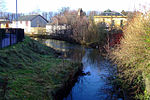Hutchesontown C
1962 establishments in Scotland1993 disasters in the United Kingdom1993 disestablishments in ScotlandBasil Spence buildingsBuildings and structures demolished in 1993 ... and 9 more
Buildings and structures in GlasgowDemolished buildings and structures in ScotlandDisasters in GlasgowDisasters in ScotlandEngvarB from October 2017Former skyscrapersGorbalsResidential buildings completed in 1962September 1993 events in the United Kingdom

Hutchesontown C was a Comprehensive Development Area (CDA) of an area of Hutchesontown, a district in the city of Glasgow, Scotland. Its centrepiece were two Brutalist 20-storey slab blocks at 16-32 Queen Elizabeth Square, designed by Sir Basil Spence and containing 400 homes. Acclaimed by architects and modernists, the flats became riddled with damp and infestations, which could not be cured even with a major renovation in the late 1980s. They were demolished in 1993, with the demolition contractor using twice the amount of explosive necessary to destroy the building, killing a female spectator in the process.
Excerpt from the Wikipedia article Hutchesontown C (License: CC BY-SA 3.0, Authors, Images).Hutchesontown C
Old Rutherglen Road, Glasgow Gorbals
Geographical coordinates (GPS) Address Nearby Places Show on map
Geographical coordinates (GPS)
| Latitude | Longitude |
|---|---|
| N 55.848 ° | E -4.246 ° |
Address
Old Rutherglen Road
Old Rutherglen Road
G5 0LT Glasgow, Gorbals
Scotland, United Kingdom
Open on Google Maps








